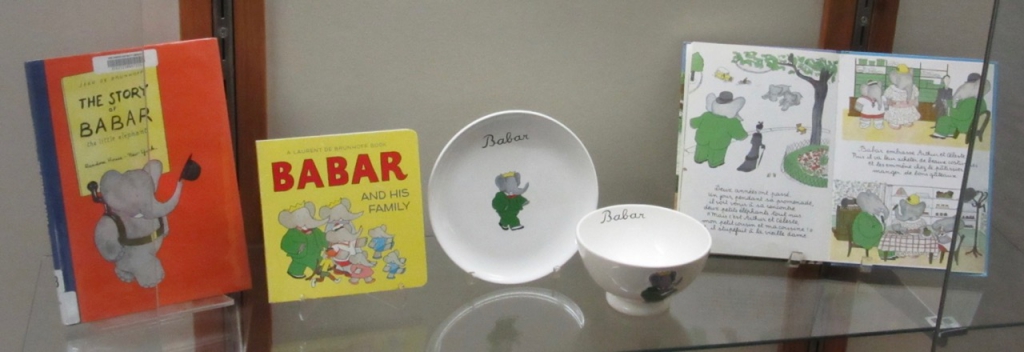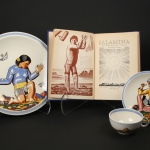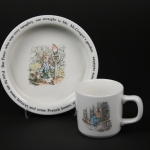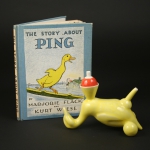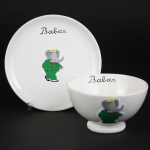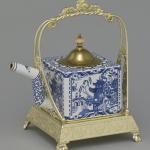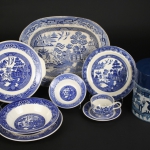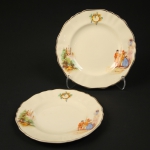Tabletop Stories
Tabletop Stories
A partnership exhibition presented by the International Museum of Dinnerware Design and the Ann Arbor District Library
Exhibition Dates: December 3, 2018 to January 26, 2019
Hours: Mon. 10am – 9 pm, Tues. – Fri. 9 am – 9 pm, Sat. 9 am – 6 pm, Sun. 12 pm – 6 pm
Location: Ann Arbor District Library, Downtown Branch, Lower Level, 343 South Fifth Ave., Ann Arbor, MI 48104
There is often a story connected with dinnerware. Perhaps the dishes were the wedding china for a couple when they got married. Sometimes families gathered together using special dishes at celebrations and memories were created. Other times the history of dinnerware involves a notable designer or the restaurant where the dishes were featured. And sometimes the stories are actually books, with dinnerware to match. Most of the time the printed material (book, music, menu) is created first. The dinnerware comes later, but is not necessarily secondary in importance. Come for the books, stay for the dinnerware. come for the dishes, stay for the books.
This special exhibition curated by the International Museum of Dinnerware Design in Ann Arbor in collaboration with the Ann Arbor District Library, pairs memorable stories published as books, operas, and restaurant menus, with the notable dinnerware that followed. Visitors may recognize at least one teapot in the form of detective Sherlock Holmes; plates, cups and saucers with Rockwell Kent illustrations from Herman Melville’s Moby Dick; and charming dishes celebrating children’s favorite book characters such as Babar and Peter Rabbit. The exhibit explores the ubiquitous Blue Willow china pattern, marketed as being derived from a Chinese legend. One may also be captivated by depictions of Charles Dickens’s characters from David Copperfield. The exhibition includes a sculptural piece of dinnerware created by contemporary ceramicist Rebecca Harvey, influenced by the children’s book The Story About Ping. Among other surprises are two versions of Aladdin’s magic lamp based on One Thousand and One Nights and produced as delightful teapots by Hall China. A favorite might be the very large restaurant meat platter rather ironically based on the historical event known as The Donner Party. Come for the books, stay for the dinnerware; come for the dishes, stay for the books.
Salamina
Salamina originated as a book both written and illustrated by Rockwell Kent (1882-1971), an American painter, printmaker, illustrator, writer, sailor, adventurer and voyager. During his lifetime he also worked as an architectural draughtsman, dairy farmer, and lobster fisherman. Salamina was first published in 1935, and it details Rockwell Kent’s second trip to Greenland. The book describes his accounts of fishing trips and Christmas festivities, shared meals and budding friendships as the reader is introduced to the Eskimo and Danish inhabitants of the small, lively community of Igdlorssuit. Salamina is Kent’s housekeeper, who becomes a central figure in the book when she and her daughter come to share his small hut for the year. (excerpted from a Goodreads book description)
While the book was a best seller in its day, the dinnerware manufactured by Vernon Kilns, also around 1935, is one of his most sought-after dinnerware designs. Prior to the production of this dinnerware, Rockwell Kent was already known for his Christmas cards, bookplates, book dust jackets, posters, and advertisements. The plate, cup and saucer are part of the permanent collection of the International Museum of Dinnerware Design. Each image is hand-tinted. Vernon kilns operated from 1931-1958 in Vernon, California.
This copy of Salaminais a first edition, owned by IMoDD. The plate is IMoDD 2016.162; and the cup and saucer IMoDD 2018.214. This plate can also be found in the permanent collection of the Detroit Institute of Arts Museum.
Moby Dick
 In 1930, Rockwell Kent (1882-1971), the American painter, printmaker, illustrator, writer, sailor, adventurer and voyager, illustrated an edition of Herman Melville’s Moby Dick. Most consider his black and white drawings both haunting and dramatic. The edition sold out almost immediately. Apparently Moby Dickhad remained a somewhat obscure book until the 1920s. Kent’s illustrations helped to bring the work to the attention of the American reading public. (excerpted from The Seattle Times, December 1, 2011)
In 1930, Rockwell Kent (1882-1971), the American painter, printmaker, illustrator, writer, sailor, adventurer and voyager, illustrated an edition of Herman Melville’s Moby Dick. Most consider his black and white drawings both haunting and dramatic. The edition sold out almost immediately. Apparently Moby Dickhad remained a somewhat obscure book until the 1920s. Kent’s illustrations helped to bring the work to the attention of the American reading public. (excerpted from The Seattle Times, December 1, 2011)
In the 1930s, Vernon Kilns (1931-1958) of Vernon, California, manufactured dinnerware featuring themes from Moby Dick, also based on Rockwell Kent’s illustrations. The designs on the dishes do not duplicate any particular illustration in the book, but are related in kind and spirit. Probably there was a copyright issue. Each plate is marked on the back “Moby Dick designed by Rockwell Kent, Vernon Kilns, Made in U.S.A.”
While his designs on dinnerware, can be found in four colors, blue, brown, maroon, and orange, the bowl on display (IMoDD 2018.80) dates from approximately 1938. The large plate/charger is IMoDD 2018.197 and the demitasse cup and saucer are IMoDD 2018.195.
Charles Dickens’ David Copperfield and Martin Chuzzlewit
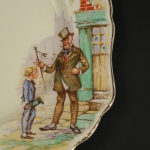
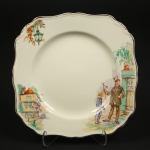
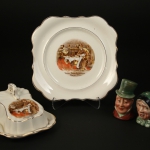

Beginning in the early 19th century, illustrating transfer-printed earthenware with depictions from literary sources, was quite popular. The domestic pottery of the time was illustrated with scenes from Walter Scott’s Old Mortality and scenes from Don Quixote. On into the mid-20thcentury, classic English literature was a popular source of decoration for English domestic dishes. A great example is the English manufacturer Lancaster & Sandland, Hanley, England, (1944-1968) who produced covered butter dishes and plates, along with Beswick Pottery that produced salt and pepper shakers, all with Dickens’ characters such as Sairey Gamp from Martin Chuzzlewit and Mr. Micawber from David Copperfield. The illustrations were sometimes accompanied by printed text such as “Sairey Gamp Entertains Betsy Prig.” There was no doubt about the literary sources. Sairey Gamp was a nurse in the novel that was first published as a serial in 1843-1844. Sairey (or Sarah) Gamp has been described as a dissolute, sloppy and generally drunk character. She appears in the dishes in the form of a butter dish (IMoDD 2017.217), plate (IMoDD 2018.201), and salt and pepper shakers (IMoDD 2018.198).
J. & G. Meakin, another English pottery, also produced dishes featuring characters from David Coppperfield. One such figure, Mr. Micawber, served as a clerk in Dickens’ novel from 1850. Included in the exhibit are J. & G. Meakin Sunshine English china, a luncheon plate (IMoDD 2017.25), a demitasse cup and saucer (IMoDD 2018.204) and a scalloped candy dish (IMoDD 2018.205).
The name Sairy (this time without the “e”) Gamp appeared again in the Adirondacks in Northern New York in 1882, as the name of a canoe built for adventurer and writer George Washington “Nessmuk” Sears. Like her tippling namesake, Nessmuk hoped his canoe would “take no water.” Nessmuk wrote about his adventures in the Sairy Gamp in 1883. In 1988, Christine Jerome retraced Nessmuk’s route which is chronicled in the book An Adirondack Passage: the Cruise of the Canoe Sairy Gamp.
Sherlock Holmes
 There are many, many Sherlock Holmes stories created by the British author Sir Arthur Conan Doyle featuring this fictional private detective. The ubiquitous silhouette image of Sherlock Holmes appears on many book covers and dust jackets. The character first appeared in print in 1887’s A Study in Scarlet.
There are many, many Sherlock Holmes stories created by the British author Sir Arthur Conan Doyle featuring this fictional private detective. The ubiquitous silhouette image of Sherlock Holmes appears on many book covers and dust jackets. The character first appeared in print in 1887’s A Study in Scarlet.
The American ceramic manufacturing company Hall China, located in East Liverpool, Ohio, has been producing dinnerware since 1903. They are best known for their dinnerware produced for restaurants and hotels. In 1987, Hall China’s chief designer, Don Schreckengost and Daniel W. Brasier, designed a teapot in the likeness of Sherlock Holmes, in honor of the 100th anniversary of the publication of Conan Doyle’s Holmes Tales No. 4. The tag on the teapot reads “Holmes by Hall, P.O. Box 221B, Flushing, MI 48433.” 221B Baker Street is the London address of the fictional detective Sherlock Holmes.
One wonders if anyone has actually served tea from one of these imposing teapots. His hat is the teapot lid; the pipe the pouring spout. It belongs to the International Museum of Dinnerware Design’s permanent collection IMoDD 2018.194.
Characters from Children’s Stories: Babar, Peter Rabbit, Ping
Illustrations of popular characters from children’s stories are familiar subjects for decorating children’s dishes and cups. Two examples, include everyone’s favorite French elephant, Babar, who first appeared in 1931 in the French children’s book Histoire de Babar by Jean de Brunhoff and the character Peter Rabbit, one of Beatrix Potter’s beloved rabbits who spent their days in Mr. McGregor’s vegetable garden.
The soup bowl and plate with Babar in hat and green suit are the promised gift of William J. Walker, Jr. The Peter Rabbit children’s dishes are from the International Museum of Dinnerware Design’s permanent collection IMoDD cup 2014.31; IMoDD plate 2014.21; and IMoDD bowl 2018.22.
Even a contemporary artist, Rebecca Harvey, was influenced by her recollections of the popular children’s book written by Marjorie Flack and illustrated by Kurt Weiss, The Story About Ping, first published in 1933. Ping was a domesticated Chinese duck lost on the Yangtze River. The sculptor’s version might not be immediately recognizable, as it is upside down and has some abstract features. The Ping sculpture is IMoDD 2014.128, and it slightly resembles a child’s pull toy.
Blue Willow
There is probably no subject/image as ubiquitous in dishware as Blue Willow. Literally hundreds of china companies have produced a version of Blue Willow since it was first issued more than 200 years ago, with no end in sight. The name is derived from the figure of a tree which occupies the center of the plate. While the pattern has an Chinese appearance, and is generally produced in blue and white, it is commonly believed that creating the legend of the Blue Willow was a clever marketing strategy of one English china manufacturer. It was first produced at the English Spode factory around 1790.
The “Chinese legend” on Blue Willow pottery tells the tragic story of a wealthy Mandarin, who had a beautiful daughter who had fallen in love with her father’s humble accounting assistant, angering her father. He dismissed the young man and built a high fence around his house to keep the lovers apart. The Mandarin wanted his daughter to marry a powerful Duke, within the same social class as his family. The Duke arrived by boat for the wedding. The young accountant, disguised as a servant, slipped into the palace unnoticed. The two lovers escaped with the jewels from the Duke, but were chased over a bridge by the Mandarin. They escaped safely to a secluded island and lived there happily for years, until the Duke learned of their whereabouts. He sent soldiers who captured and killed the lovers. The sympathetic gods transformed the lovers into a pair of doves, that now frequently appear on Blue Willow patterned dishes. (excerpted by Wikipedia)
Some sources say that the authentic Blue Willow pattern has: willow trees, Chinese pine trees, a bridge with three men on it, a fence, and a boat. The doves were a later addition.
Our pop up exhibition, Tabletop Stories, includes many Blue Willow patterned dishes and dinnerware related objects. Examples include dishes by Royal China of Sebring, Ohio (IMoDD 2018.215); English Wedgwood (IMoDD 2017.176); Hall China, East Liverpool, Ohio (IMoDD 2018.206, 2018.207); cannisters (IMoDD 2017.159; Léopold Foulem “tea pot” Blue Willow (IMoDD 2013.46); a children’s tin toy dishes set (IMoDD 2017.147); an English bone china platter in transferware (IMoDD 2018.196).
The book Blue Willow by Doris Gates has been described a child’s version of The Grapes of Wrath. It is the story of the ten-year-old daughter of a poor migrant family during the Great Depression in the 1930s. Her most treasured possession is a Blue Willow plate that had belonged to her great-great-grandmother. The image on the plate represented her dreams of a permanent home. Most other books relating to the topic of Blue Willow, portray the Chinese legend in full glory. One example is The Willow Pattern Story by Allan Drummond.
Alice’s Adventures in Wonderland

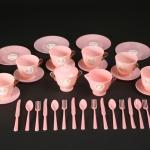

Alice’s Adventures in Wonderland is an 1865 novel written by English author Charles Lutwidge Dodgson under the pseudonym Lewis Carroll. Everyone knows the story of the girl, Alice, falling through a rabbit hole into a fantasy world populated by the characters such as the Cheshire cat, the White Rabbit, the Dodo, the Caterpillar, the Queen of Hearts, the Hatter, the March Hare, to name a few. It is these characters that appear on the plastic toy children’s dish tea sets that are created in 1940s-1950s that are included in this exhibition, with one set shown in original box (IMoDD 2018.216; IMoDD 2018.217).
But the first object relating to the theme of Alice’s Adventures in Wonderland, acquired by the International Museum of Dinnerware Design for the permanent collection, was not a set a child’s dishes, but rather the delightful version in the form of a pop up book by Lewis Carroll and Robert Sabuda. Each page turn is a triumph in pop up book creation and production (IMoDD 2014.177).
The Donner Party
 Some stories may not begin as books, but rather as historic incidents. Such is the case of the Donner Party. It is, of course, the tragic tale of the American pioneers who set out for California in a wagon train in May 1846. Their point of departure was Independence, Missouri, and they were delayed in their journey during the winter of 1846-47, stranded, snowbound in the Sierrra Nevada Mountains. The group originally numbered around 90, but they were purportedly reduced to cannibalism to survive the ordeal, and less than half the original members survived.
Some stories may not begin as books, but rather as historic incidents. Such is the case of the Donner Party. It is, of course, the tragic tale of the American pioneers who set out for California in a wagon train in May 1846. Their point of departure was Independence, Missouri, and they were delayed in their journey during the winter of 1846-47, stranded, snowbound in the Sierrra Nevada Mountains. The group originally numbered around 90, but they were purportedly reduced to cannibalism to survive the ordeal, and less than half the original members survived.
There are books, movies, and even dishes depicting this sad story. One recently published book is Desperate Passage: The Donner Party’s Perilous Journey Westby Ethan Rarick. A more ironic approach to this subject is a restaurant ware meat platter manufactured by Tepco (Technical Porcelain and China Ware Company, El Cerrito, California) which depicts “The Donner Party 1846” in a sepia toned transferware pattern with covered wagons, horses, oxen, and Western vignettes along the border of the oval platter. It includes the words “Early California.” It’s a meat platter. Probably someone with a morbid sense of humor came up with the idea. IMoDD 2017.222.
Aladdin
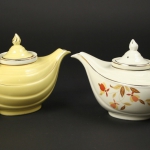 The story of Aladdin is well-known in literature. It is part of the Arabian Nights or One Thousand and One Nights, told by Scheherazade. This sultan’s concubine told this tale and other stories to the sultan in narratives that could be paused in the middle, to be continued the next night, so as to save her life (since she learned that the Sultan killed his concubines, once he was satisfied with them). Interestingly, scholars have learned that the original Aladdin story was not set in Arabia or the Middle East, but in China. Aladdin is a Chinese boy living at home with his mother, in the original version. Nonetheless, the story includes a magic lamp (with a genie) that grants wishes, so the story goes.
The story of Aladdin is well-known in literature. It is part of the Arabian Nights or One Thousand and One Nights, told by Scheherazade. This sultan’s concubine told this tale and other stories to the sultan in narratives that could be paused in the middle, to be continued the next night, so as to save her life (since she learned that the Sultan killed his concubines, once he was satisfied with them). Interestingly, scholars have learned that the original Aladdin story was not set in Arabia or the Middle East, but in China. Aladdin is a Chinese boy living at home with his mother, in the original version. Nonetheless, the story includes a magic lamp (with a genie) that grants wishes, so the story goes.
That magical lamp was turned into a few thousand teapots (some with infusers) by the Hall China Company in East Liverpool, Ohio. These teapots, called Aladdin for their shape, were introduced in 1939. There are many variations in color, form, and decoration. Two examples in the permanent collection of the International Museum of Dinnerware Design, include Autumn Leaf by Jewel for Hall’s (IMoDD 2018.213) and a lovely daffodil colored version (IMoDD 2018.203)
The Yeomen of the Guard by Gilbert and Sullivan
The Yeomen of the Guard (also known as The Merryman and His Maid) is an opera by Gilbert and Sullivan that premiered at the Savoy Theatre on October 3, 1880, and ran for 423 performances. Arthur Sullivan composed the music and the libretto was created by W.S. Gilbert. It was their eleventh collaboration of fourteen.
The opera is set in the Tower of London in the 16thcentury and has been described as a comic tragedy, involving several couples who end up engaged, and one broken hearted main character who ends up sadly alone.
The Ann Arbor District Library owns the musical score. The International Museum of Dinnerware Design owns two small plates manufactured by the English domestic china producer, J. & G. Meakin. The plates include images of the lead characters and the Tower of London (IMoDD 2018.192; IMoDD 2018.193).

